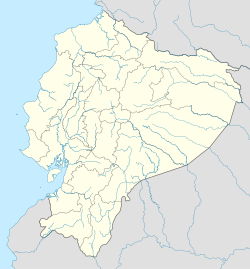Zaruma
| Zaruma | |||
|---|---|---|---|
| Villa Real De San Antonio del Cerro de Oro de Zaruma | |||
|
|||
| Nickname(s): Sultana de El Oro | |||
| Location of Zaruma within Ecuador | |||
| Coordinates: 03°41′00″S 79°36′00″W / 3.68333°S 79.60000°WCoordinates: 03°41′00″S 79°36′00″W / 3.68333°S 79.60000°W | |||
| Country | Ecuador | ||
| Province | El Oro Province | ||
| Canton | Zaruma Canton | ||
| Foundation | December 8, 1595 | ||
| Founded by | Damian Meneses | ||
| Named for | zara and huma | ||
| Government | |||
| • Type | Mayor and council | ||
| • Governing body | Ec. Danilo Mora | ||
| Areaapprox. | |||
| • Total | 0.1 km2 (0.04 sq mi) | ||
| Elevation | 1,200 m (3,900 ft) | ||
| Population (2011) | |||
| • Total | 22,222 | ||
| • Density | 220,000/km2 (580,000/sq mi) | ||
| • Demonym | Zarumeño(-a) | ||
| Time zone | ECT (UTC-5) | ||
| Postal code | EC071150 (new format) | ||
| Area code(s) | (0)72972, (0)72973 | ||
| Website | http://www.zaruma.gob.ec | ||
Zaruma, officially Villa Real de San Antonio del Cerro de Oro de Zaruma is a town in the south of Ecuador, El Oro Province. It is located in the south-east of this province, at an altitude of 1200 metres above sea level, on an inter-Andes route where the Vizcaya mountain range branches off from the Chilla mountain range. It is the seat of Zaruma Canton, one of the oldest cantons in the province, and is considered to be one of Ecuador's most beautiful cities.
Zaruma is famous for its republic-era architecture, gold mines, culture and traditions, art and coffee and for having been founded by Spanish explorer Alonso de Mercadillo. These attributes have led to its receiving various titles celebrating both its tangible and intangible aspects, and in 1998 the Ecuadorian Institute for Cultural Heritage submitted it as a candidate UNESCO World Heritage Site.
The word Zaruma is formed from two quichua words: sara, which means corn, and uma, which means head. That is to say, Zaruma to translates to "corn head", a name attributed to the existing corn and to the gold mined here, which is similar in colour to a corncob. It is not known why the spelling was altered from "Saruma" to "Zaruma". However, historian Jorge Núñez claims that Zaruma means "small mountain peak".
It is believed that one of the few states existing among early settlers was Zarzas, which contained eleven tribes: the Cariamangas, Catacochas, Catamayus, Gonzanamaes, Guachanamaes, Malacatos, Piscobambas, Vilcabambas, Yanganas and Zarumas.
It is believed that the Cañari settled in what is now Zaruma canton between 500 and 1400 CE. This is supported by the existence of important archeological sites such as Guayquichuma, Chepel, Payama, Trencilla, San Antonio, Chiva Turco, Tocto Shuqin, Guartiguro, among others, all of which have been attributed to the Cañari.
In the 1480s, the Cañari settled in Zaruma were overpowered by the Incas who were then under the command of Huayna Capac. After ordering his subordinates to explore the north, they invaded the Zaruma basin, enslaving the indigenous Cañari for 50 years.
...
Wikipedia



